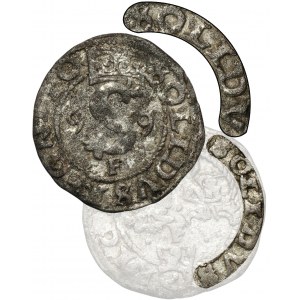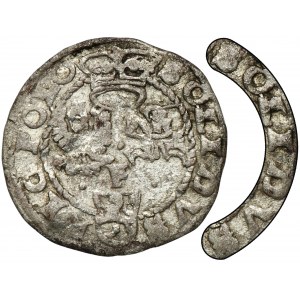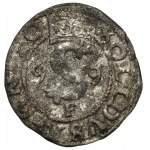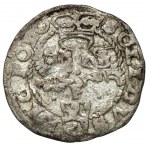Extremely rare variety of the Wschowa shekel with the inscription SOLIDVS on both sides of the coin, under the royal monogram the letter F.
The coin comes from the collection of Dariusz Marzęta.
In Edmund Kopicki's catalog, the degree of rarity is specified as R5.
An extremely sporadic item on the auction market.
The background of the monetary history of the Republic of Poland during the reign of Sigismund Vasa was the progressing monetary crisis caused by the situation in Germany and the influx of German coinage into Poland. Initially, the mint rate was determined by Stefan Batory's ordinance of 1580. With the crisis deepening, in 1601 it was decided to raise the mint rate, i.e. devalue the denominations in circulation. The following years saw further legislation lowering the silver content of various denominations. Of these, the most important was the Ordinance of 1623. It introduced a stable monetary system, based on the monetary system of the Empire. During the reign of Sigismund III, new denominations appeared in the Polish-Lithuanian Commonwealth - three-cornered coins, halves and orts. On the other hand, in 1621, the highest denomination in the history of Polish money - the hundred-drachma - was minted at the Bydgoszcz mint. This was the crowning achievement of the intensive issuance of gold coins during the reign of Sigismund III. Crown mints (Olkusz, Wschowa, Poznań, Malbork, Bydgoszcz, Lublin, Kraków, Warsaw), Lithuanian mints (Vilnius), municipal mints (Gdańsk, Elbląg, Toruń, Riga, Poznań, Wschowa) and a private mint in Łobżenica worked during this period. Sigismund Vasa's Swedish coins were issued by mints in Stockholm, Rewal and Malbork. In 1627, a decision was made to stop issuing small coinage. This decision remained in force until 1650.
During the reign of Sigismund III, shillings were issued by eight crown mints (Olkusz, Wschowa, Poznan, Malbork, Bydgoszcz, Lublin, Cracow and Warsaw), the Lithuanian mint in Vilnius and the municipal mint in Riga. The piece of Elblag shekel described in the literature - a unique piece from the Potocki collection - is a forgery (probably from the era). During the reign of Sigismund III the Elblag mint did not operate. In 1591, an ordinance went into effect ordering that the mintmarks of those responsible for mint production at a particular establishment be placed on coins. In the case of shekels, this now makes it much easier to assign particular varieties to specific mints. Starting in 1599, the mintmarks of the minters were replaced by the initials of the cities where the mints were located. In the first years of the reign of Sigismund III, the 1580 ordinance of Stefan Batory was in effect, under which shekels of 0.204 grams of pure silver were minted. In 1604, under the constitution of the Warsaw Sejm, the silver content was reduced more than twice, to 0.091 g. In 1623, a resolution of the Treasury Commission further reduced the content of pure bullion in shekels - to 0.084 g. Crown shekels minted under the acts of 1604 and 1623 were treated as sub-value money. Consequently, two ways of setting prices for a given commodity emerged: the price calculated in normal coin (lower) and the price in shekel coin (higher). At the Vilna mint, which resumed work after a hiatus of several years (1614), shekels were minted on the basis of a 1612 regulation, which set the shekel's pure bullion content at 0.158 grams. Starting in 1623, the Vilnius mint began using the aforementioned resolution of the Treasury Commission (0.084 g of silver). The Riga mint ignored the 1604 resolution and until 1620 issued shekels according to Stefan Batory's ordinance of 1580, while in 1620-1621 - according to the ordinance of 1612.











